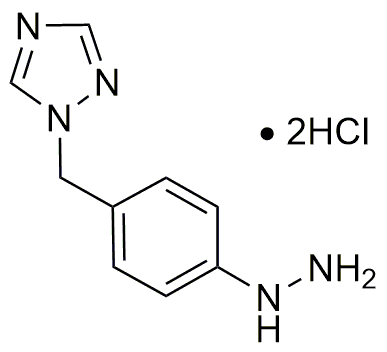1-(4-Hydrazinobenzyl)-1H-1,2,4-triazole dihydrochloride is widely utilized in research focused on:
- Agricultural Chemistry: This compound is explored for its potential as a fungicide, helping to protect crops from fungal infections, thereby enhancing agricultural productivity.
- Pharmaceutical Development: It serves as a key intermediate in synthesizing various pharmaceuticals, particularly in developing anti-cancer agents, due to its ability to inhibit specific cellular pathways.
- Material Science: Researchers are investigating its properties for creating novel materials with unique thermal and electrical conductivity, which can be beneficial in electronics.
- Biochemical Research: The compound is used in studies related to enzyme inhibition, providing insights into metabolic pathways and potential therapeutic targets.
- Environmental Science: It is being evaluated for its role in developing eco-friendly pesticides, aiming to reduce the environmental impact of traditional chemical treatments.
Información general
Propiedades
Seguridad y normativas
Aplicaciones
1-(4-Hydrazinobenzyl)-1H-1,2,4-triazole dihydrochloride is widely utilized in research focused on:
- Agricultural Chemistry: This compound is explored for its potential as a fungicide, helping to protect crops from fungal infections, thereby enhancing agricultural productivity.
- Pharmaceutical Development: It serves as a key intermediate in synthesizing various pharmaceuticals, particularly in developing anti-cancer agents, due to its ability to inhibit specific cellular pathways.
- Material Science: Researchers are investigating its properties for creating novel materials with unique thermal and electrical conductivity, which can be beneficial in electronics.
- Biochemical Research: The compound is used in studies related to enzyme inhibition, providing insights into metabolic pathways and potential therapeutic targets.
- Environmental Science: It is being evaluated for its role in developing eco-friendly pesticides, aiming to reduce the environmental impact of traditional chemical treatments.
Documentos
Hojas de datos de seguridad (HDS)
La SDS proporciona información de seguridad completa sobre la manipulación, el almacenamiento y la eliminación del producto.
Especificación del producto (PS)
La PS proporciona un desglose completo de las propiedades del producto, incluida la composición química, el estado físico, la pureza y los requisitos de almacenamiento. También detalla los rangos de calidad aceptables y las aplicaciones previstas del producto.
Certificados de análisis (COA)
Busque certificados de análisis (COA) ingresando el número de lote del producto. Los números de lote y de partida se pueden encontrar en la etiqueta de un producto después de las palabras "Lote" o "Lote".
Número de catálogo
Número de lote/lote
Certificados de origen (COO)
Este certificado de origen confirma el país en el que se fabricó el producto y también detalla los materiales y componentes utilizados en él y si se deriva de fuentes naturales, sintéticas u otras fuentes específicas. Este certificado puede ser necesario para cumplir con las normativas aduaneras, comerciales y regulatorias.
Número de catálogo
Número de lote/lote
Hojas de datos de seguridad (HDS)
La SDS proporciona información de seguridad completa sobre la manipulación, el almacenamiento y la eliminación del producto.
DownloadEspecificación del producto (PS)
La PS proporciona un desglose completo de las propiedades del producto, incluida la composición química, el estado físico, la pureza y los requisitos de almacenamiento. También detalla los rangos de calidad aceptables y las aplicaciones previstas del producto.
DownloadCertificados de análisis (COA)
Busque certificados de análisis (COA) ingresando el número de lote del producto. Los números de lote y de partida se pueden encontrar en la etiqueta de un producto después de las palabras "Lote" o "Lote".
Número de catálogo
Número de lote/lote
Certificados de origen (COO)
Este certificado de origen confirma el país en el que se fabricó el producto y también detalla los materiales y componentes utilizados en él y si se deriva de fuentes naturales, sintéticas u otras fuentes específicas. Este certificado puede ser necesario para cumplir con las normativas aduaneras, comerciales y regulatorias.


